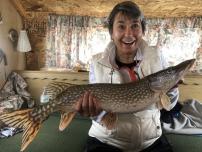
For a while, the question loomed large: Would the 2025 version of The Last Great Race be, well, the very last? Iditarod Trail Sled Dog Race, more commonly known as The Iditarod, and one of Alaska’s longest-running traditions, was (and to be honest, still is) in financial jeopardy.
A loss of sponsors and in 2022, the loss of its host hotel, put the race at risk. Several major race sponsors ended their support for the race over the course of the last several years, after pressure from animal rights organizations. Sponsors who pulled their funds included the pet food company Nutanix, Alaska Airlines, ExxonMobil and Coca Cola, as well as Jack Daniel’s Tennessee Whiskey and Wells Fargo.
2025 was a particularly hard year for the race, as well; three dogs died on the trail, ending the Iditarod’s five-year streak without a dog death, and five more dogs died in training when teams were struck by snowmobiles.

Note: Rescues are at work helping retired racing sled dogs; one organization, the August Foundation for Alaska Racing Dogs, seeks to provide veterinary care and find loving homes for dogs who can no longer race. The August Fund has also worked to provide neon-colored harnesses to sled dogs while training in order to make them more visible.
The race was dealt another blow when a state legislative committee denied a $1.4 million funding request that race officials said would have buoyed the struggling event.
Alaska Public Media notes, “The loss of major sponsors isn’t the only problem. Race officials have cited economic realities. Inflation has increased the cost of dog food substantially. Some mushers report spending more than $40,000 per year to feed their teams. Many mushers are also reeling from the COVID-19 pandemic, when travel restrictions closed off opportunities to offer sled dog tours to tourists, a source of off-season income for many.”
Climate change has not helped either. A lack of snow has meant that although the race still has its festive ceremonial start in Anchorage, there is not enough snow to allow for safe passage. The actual race starts the next day in the city of Willow, about 50 miles north. Willow, while snowy, is a small town (at the 2020 census the population was 2,196), and it lacks much of Anchorage’s tourist-friendly amenities.
Organizers promoted a regularly-offered raffle to boost fundraising efforts for the race, whose roots stretch back to 1925, when sled dog mushers delivered an diphtheria antitoxin serum to Nome, following a 1,000-mile trip from Anchorage that took five and a half days and included hand-offs of the serum to different mushers and teams.
The first Iditarod Trail Sled Dog Race took place in 1973 to honor the mushers and teams who carried serum on the perilous route. According to Wikipedia, while the winner of the 1973 event completed the competition in just over 20 days, preparation of the trail in advance of the dog sled teams and improvements in dog training have dropped the winning time to under 10 days in every race since 1996.
Now, 52 years later, the race continues to face down one of its greatest challenges – and it’s not snow.
“Currently, we are facing a $350,000 deficit to our operating budget,” noted organizers on the site. “Our operating budget exceeds $4,000,000, and the Winter and Summer Raffles are absolutely critical in ensuring we can continue this monumental race. Without a sell-out, the future of the Iditarod is in jeopardy.”
“This may sound dramatic, but it is absolutely the unfortunate truth,” organizers wrote. “Without this fundraiser and the sale of these tickets, we would not be able to put this race on each year.”

According to the website, the race had to shell out quite a bit to cover its expenses, including food for 1,500 volunteers stationed throughout the entire race, fuel for transportation of supplies, humans and canines, straw to keep dogs warm, veterinary care along the trail with multiple veterinarians at each checkpoint, educational programs and curriculums in schools and multitudinous other costs associated with the race.
A graphic for the race showed a map, likening funds raised to miles traveled toward the goal.
“Just a few hundred tickets left! You've taken us so far up the trail, and now we're almost to Nome. Let's make it to the finish line,” pleaded one email.
And finally, it did. An announcement on the website posted the day after the raffle noted that the support “played a direct role in helping fuel the journey to Iditarod 2026, and we couldn't be more grateful.”
The race is safe… for now. But with the lack of lawmaker funding and sponsorship support, it’s unlikely this will be the last concern for the last great race.

